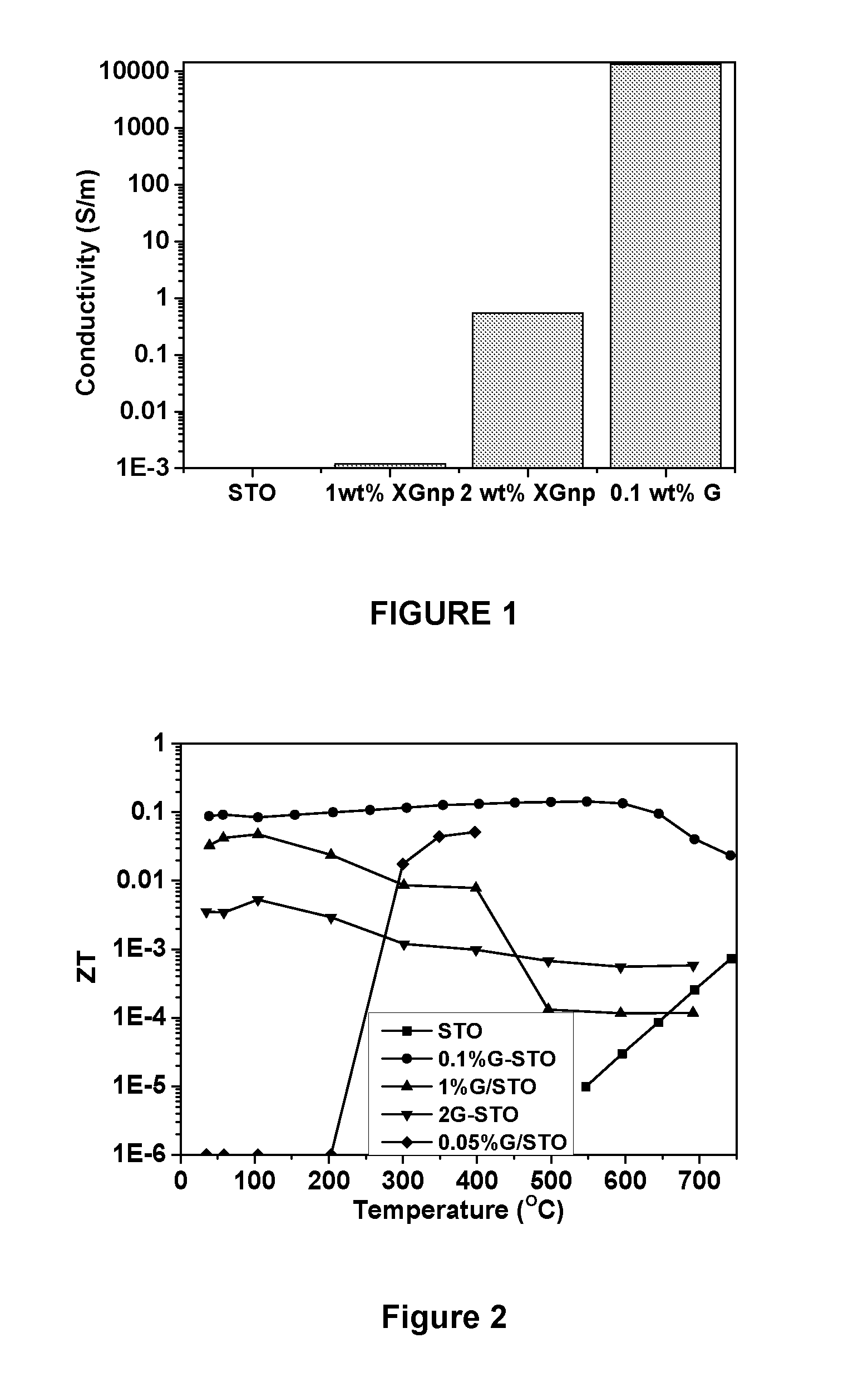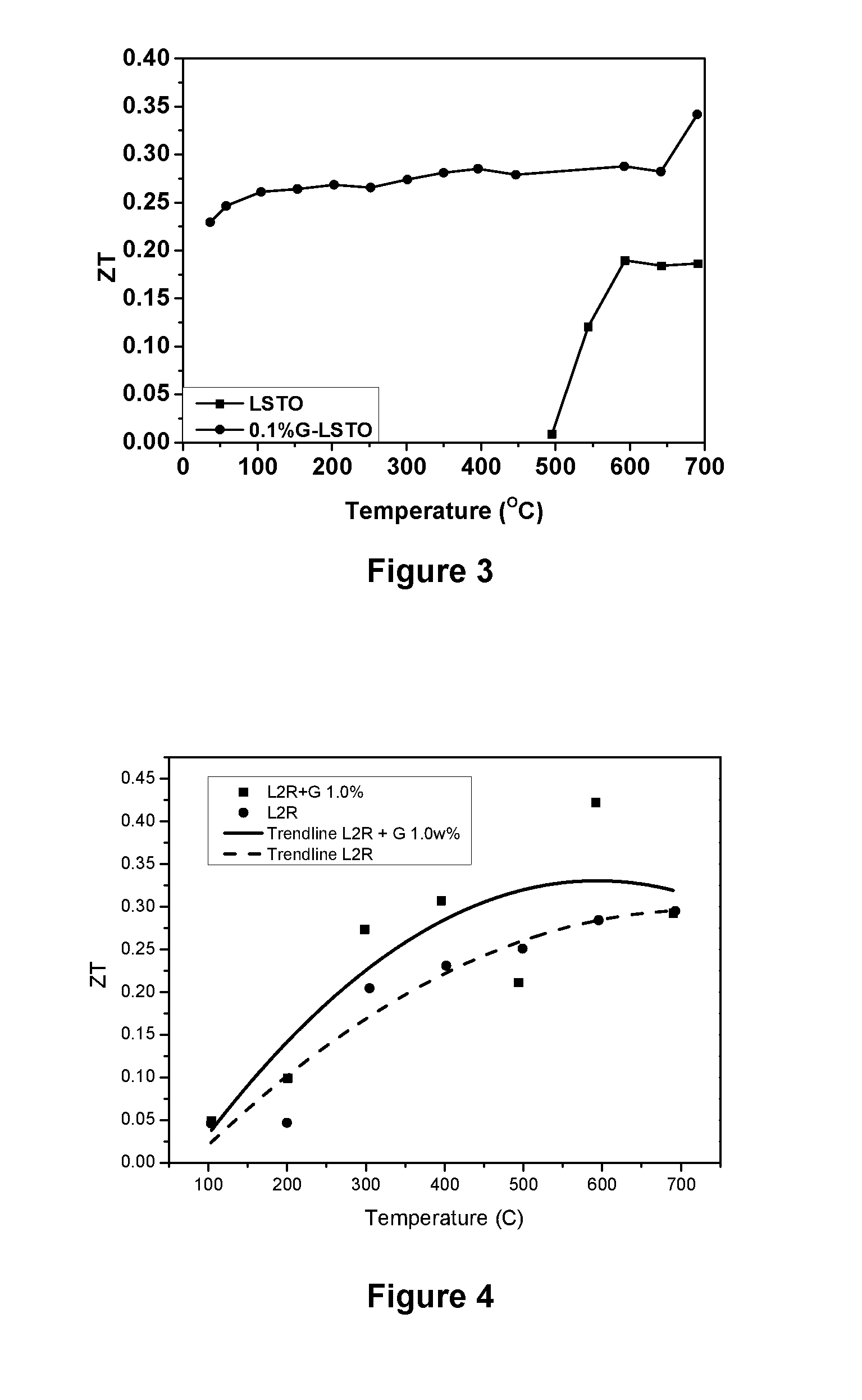Thermoelectric Materials and Devices Comprising Graphene
a graphene and material technology, applied in the field of thermoelectric power generation, can solve the problems of insufficient zt values insufficient zt value, etc., and achieve the effects of linear power generation response, lighter power generation devices, and reduced density of materials
- Summary
- Abstract
- Description
- Claims
- Application Information
AI Technical Summary
Benefits of technology
Problems solved by technology
Method used
Image
Examples
example 1
[0138]Ca(NO3)2, Co(NO3)2.6H2O, La(NO3)3.6H2O, and citric acid can be used as raw materials. Mixtures of the above ingredients in the appropriate proportions to provide nominal compositions of Ca3Co4O9 and (La0.1Ca0.9)3Co4O9 can be thoroughly dissolved in distilled water, respectively, and then heated to form a transparent gel. The dried gel can be ground and calcined at 800° C. for 2 h to form the precursor powders. The ceramic bulk samples can be compacted in vacuum in a SPS apparatus. The powder precursors were sintered by spark plasma sintering (SPS) method at 900° C. for 5 min. The samples can then be forged in the same SPS apparatus by loading 750° C. predensified cylindrical samples with a diameter of 15 mm and a height of 5 mm into a die with inner diameter of 20 mm and heated up with a heating rate of 100° C. / min in vacuum to the preset deformation temperature of 900° C. A constant uniaxial load that corresponded to an initial compressive stress of 40 Mpa can be applied when...
example 2
[0139]Ceramic powders with nominal compositions Ca3Co4O9 (p-type) and Ca0.95Sm0.05MnO3 (n-type) can be synthesized from stoichiometric amounts of CaCO3, Co3O4, Sm2O3 and MnO2 by “solid state reaction”. The precursor powders can be mixed and calcinated twice at 900° C., for 12 h with intermediate grindings to obtain a homogeneous composition. The mixture powder can be first formed into a cylindrical pellet (24 mm diameter) or bars 4 mm×4 mm×35 mm) under 30 MPa using a compacting cell. The cobaltite samples can be sintered in air at 920° C., for 24 h. Polyvinyl alcohol can be used as a binder in the case of the manganite compaction due to the coarser starting particle size. The processing temperature of the n-type material can be 1350° C., 12 h. A platinum plate should be used between the sample and Al2O3 crucible to prevent the reaction between the material and the support.
example 3
[0140]For Ag-doped Ca3-xAgxCo4O9 (x=0, 0.1 and 0.3) polycrystalline samples, reagent grade CaCO3, Co2O3 and AgNO3 powders in the stoichiometric ratio can be mixed thoroughly and calcined in air at 1173 K for 12 h. Then the mixture can be reground, pressed into pellets and sintered at 1173 K for 36 h under an 02 flow with an intermediate grinding. The pellets can be pulverized manually for 1 h, and then the powders were cold pressed into disc-shaped pellets under a high pressure of 3 GPa with a special die. Finally, the above pellets can be sintered under 02 flow at 1173 K for 12 h.
[0141]For Ag-added Ca3CO4O9 ceramic composites, the prepared Ca3Co4O9 powders can be mixed with Ag2O powders in three different weigh ratios to Ca3Co4O9:3.5 wt %, 10 wt % and 20 wt %. (The Ag element concentration of 3.5 wt % and 10 wt % Ag-added samples will be equal to that of x=0.1 and 0.3 Ag-doped samples, respectively.) The mixed powders can also be cold pressed under 3 GPa and then sintered at 1173 K...
PUM
| Property | Measurement | Unit |
|---|---|---|
| temperature | aaaaa | aaaaa |
| temperature | aaaaa | aaaaa |
| temperature | aaaaa | aaaaa |
Abstract
Description
Claims
Application Information
 Login to View More
Login to View More - R&D
- Intellectual Property
- Life Sciences
- Materials
- Tech Scout
- Unparalleled Data Quality
- Higher Quality Content
- 60% Fewer Hallucinations
Browse by: Latest US Patents, China's latest patents, Technical Efficacy Thesaurus, Application Domain, Technology Topic, Popular Technical Reports.
© 2025 PatSnap. All rights reserved.Legal|Privacy policy|Modern Slavery Act Transparency Statement|Sitemap|About US| Contact US: help@patsnap.com



